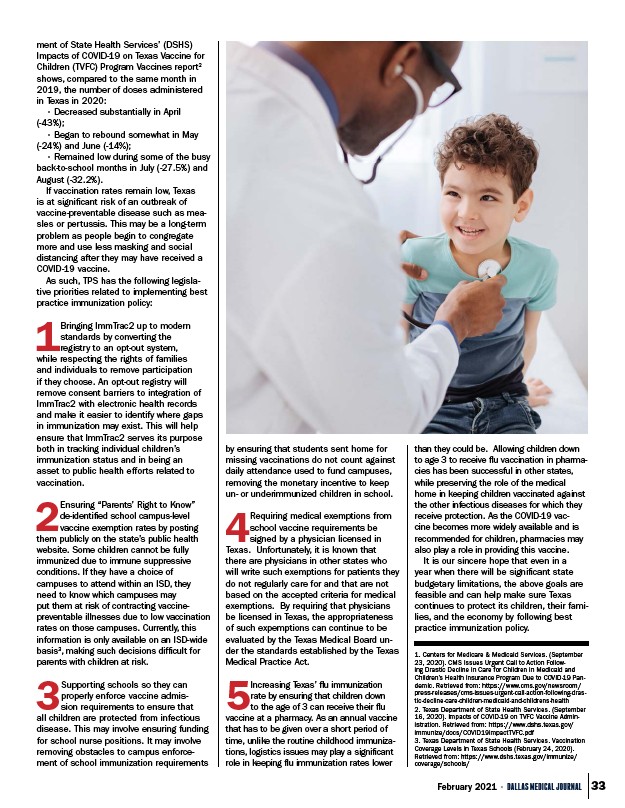
February 2021 • DALLAS MEDICAL JOURNAL 33
ment of State Health Services’ (DSHS)
Impacts of COVID-19 on Texas Vaccine for
Children (TVFC) Program Vaccines report2
shows, compared to the same month in
2019, the number of doses administered
in Texas in 2020:
• Decreased substantially in April
(-43%);
• Began to rebound somewhat in May
(-24%) and June (-14%);
• Remained low during some of the busy
back-to-school months in July (-27.5%) and
August (-32.2%).
If vaccination rates remain low, Texas
is at significant risk of an outbreak of
vaccine-preventable disease such as measles
or pertussis. This may be a long-term
problem as people begin to congregate
more and use less masking and social
distancing after they may have received a
COVID-19 vaccine.
As such, TPS has the following legislative
priorities related to implementing best
practice immunization policy:
1Bringing ImmTrac2 up to modern
standards by converting the
registry to an opt-out system,
while respecting the rights of families
and individuals to remove participation
if they choose. An opt-out registry will
remove consent barriers to integration of
ImmTrac2 with electronic health records
and make it easier to identify where gaps
in immunization may exist. This will help
ensure that ImmTrac2 serves its purpose
both in tracking individual children’s
immunization status and in being an
asset to public health efforts related to
vaccination.
2Ensuring “Parents’ Right to Know”
de-identified school campus-level
vaccine exemption rates by posting
them publicly on the state’s public health
website. Some children cannot be fully
immunized due to immune suppressive
conditions. If they have a choice of
campuses to attend within an ISD, they
need to know which campuses may
put them at risk of contracting vaccinepreventable
illnesses due to low vaccination
rates on those campuses. Currently, this
information is only available on an ISD-wide
basis3, making such decisions difficult for
parents with children at risk.
3Supporting schools so they can
properly enforce vaccine admission
requirements to ensure that
all children are protected from infectious
disease. This may involve ensuring funding
for school nurse positions. It may involve
removing obstacles to campus enforcement
of school immunization requirements
by ensuring that students sent home for
missing vaccinations do not count against
daily attendance used to fund campuses,
removing the monetary incentive to keep
un- or underimmunized children in school.
4Requiring medical exemptions from
school vaccine requirements be
signed by a physician licensed in
Texas. Unfortunately, it is known that
there are physicians in other states who
will write such exemptions for patients they
do not regularly care for and that are not
based on the accepted criteria for medical
exemptions. By requiring that physicians
be licensed in Texas, the appropriateness
of such expemptions can continue to be
evaluated by the Texas Medical Board under
the standards established by the Texas
Medical Practice Act. 5Increasing Texas’ flu immunization
rate by ensuring that children down
to the age of 3 can receive their flu
vaccine at a pharmacy. As an annual vaccine
that has to be given over a short period of
time, unlike the routine childhood immunizations,
logistics issues may play a significant
role in keeping flu immunization rates lower
than they could be. Allowing children down
to age 3 to receive flu vaccination in pharmacies
has been successful in other states,
while preserving the role of the medical
home in keeping children vaccinated against
the other infectious diseases for which they
receive protection. As the COVID-19 vaccine
becomes more widely available and is
recommended for children, pharmacies may
also play a role in providing this vaccine.
It is our sincere hope that even in a
year when there will be significant state
budgetary limitations, the above goals are
feasible and can help make sure Texas
continues to protect its children, their families,
and the economy by following best
practice immunization policy.
1. Centers for Medicare & Medicaid Services. (September
23, 2020). CMS Issues Urgent Call to Action Following
Drastic Decline in Care for Children in Medicaid and
Children’s Health Insurance Program Due to COVID-19 Pandemic.
Retrieved from: https://www.cms.gov/newsroom/
press-releases/cms-issues-urgent-call-action-following-drastic
decline-care-children-medicaid-and-childrens-health
2. Texas Department of State Health Services. (September
16, 2020). Impacts of COVID-19 on TVFC Vaccine Administration.
Retrieved from: https://www.dshs.texas.gov/
immunize/docs/COVID19impactTVFC.pdf
3. Texas Department of State Health Services. Vaccination
Coverage Levels in Texas Schools (February 24, 2020).
Retrieved from: https://www.dshs.texas.gov/immunize/
coverage/schools/